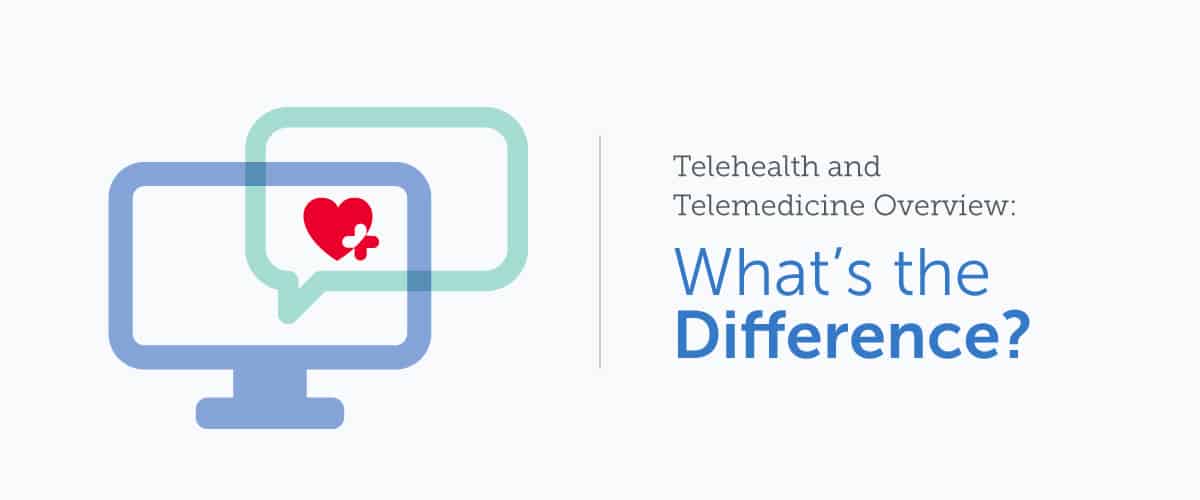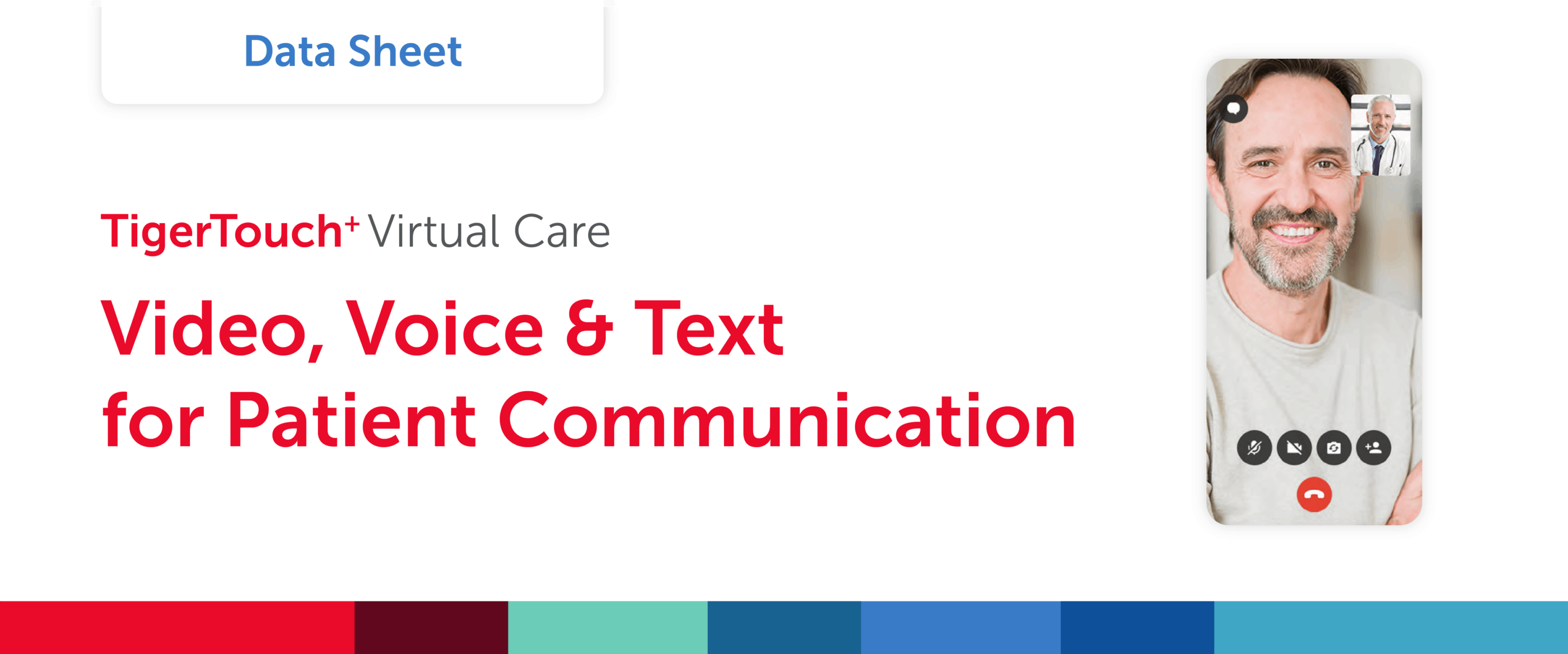Home / Blog /
Telehealth and Telemedicine Overview: What’s the Difference?

Telehealth and Telemedicine Overview: What’s the Difference?
The terms “telehealth” and “telemedicine” are often used interchangeably. You can quickly find many articles and posts and even large healthcare organizations that say this is fine.
But the terms have different meanings, and after you finish reading this article, you’ll know how – and why – to use the words correctly.

Telehealth and Telemedicine Overview
In 1906, Dr. Willem Einthoven transmitted an ECG report over a telephone line from a physiology lab to a hospital a mile away. That event marked the first baby steps of the use of telecommunications technology to deliver a healthcare service from a distance.
In 1948, clinicians sent radiology images over 24 miles of telephone lines from West Chester, Pennsylvania, to Philadelphia. Toddler steps.
In 1959, the University of Nebraska clinicians set up a two-way television connection to transmit neurological exams to medical students on campus. Five years later, they performed video consults and speech therapy services to patients at Norfolk State Hospital, 112 miles away. Our child is walking steadily now.
The prefix “tele” means “from a distance,” so we’d be accurate labeling all these remote healthcare services as telehealth.
Or should we call them telemedicine, since they represent the practice of medicine over a distance?
And here we see the confusion. When is it telehealth, and when is it telemedicine?
It doesn’t help that we have no standard, everybody-agrees definitions for the terms telehealth and telemedicine. Both terms refer to the use of electronic communications to help people become and stay healthy from a distance.
So what’s the difference? Let’s look closer at each word and figure this out.
What is Telehealth?
The Department of Health and Human Services’ (HHS) Health Resources and Services Administration (HRSA) says telehealth is “the use of electronic information and telecommunications technologies to support and promote long-distance clinical health care, patient and professional health-related education, public health, and health administration.”
Let’s break it down.
- “Electronic information” includes digital images, videos, or text files stored on a computer.
- “Telecommunications Technologies” could be Smartphones, wearable devices, the Internet, and video conferencing, streaming media, and landlines and wireless communications.
- “Long-distance” could be one mile or 1,000 miles. The idea is that the two parties involved in the interaction cannot see each other in person, but physical walls are no barrier.
- The services provided are both clinical and non-clinical.
- The services provided can be between a clinician and a patient and their family, between multiple clinicians, or even between two medical devices.
The HRSA also defines four ways telehealth is delivered:
- Video Conferencing – A real-time, two-way interaction that supports health care services. Since all participants in a videoconference can interact with each other, this method is considered synchronous. One example is a dermatologist examining a suspicious mole over a live video feed. Another is a medical consult. A third example is 30 doctors at 30 locations attending a remote training session broadcast from an academic medical center.
- Store and Forward – The transmission of digital images, pictures, video, or text that was recorded and stored before being sent. Since there is no real-time interaction between the participants, this method is considered asynchronous. An example is a patient taking a picture of a tooth injury and texting it to their dentist.
- Remote Patient Monitoring (RPM) – The transmission of health or medical data such as blood pressure, glucose readings, and blood oxygen. RPM technologies require varying levels of intervention by the patient and can send data on a predetermined schedule or as needed. Some of the conventional measurement devices are:
-
- Digital stethoscopes
- Ophthalmoscopes (eye exams)
- Otoscopes (ear exams)
- Smartphone cameras
- Vital sign monitoring devices
- Wearable biosensors such as wristbands and heart rate monitors
- Mobile Health – Also known as mHealth, it is the use of mobile devices such as tablets and Smartphones to transmit health information. An example is preoperative instructions texted to a patient to prepare for a surgical procedure.
By now, you see the term telehealth covers a lot of ground. Telehealth includes:
- A neurology consult
- Remote monitoring of vital signs
- A remote physical therapy session
- Ongoing education for medical professionals
- A patient logging into a portal to review their lab results.
- A scheduled text message reminding a patient to get a flu shot
Telehealth reaches across most disciplines, including psychiatry, dentistry, social work, home health, cardiology, and physical therapy. It’s all about providing better clinical services to patients.
With so many applications handled by telehealth, you might be wondering, what’s left for telemedicine? Let’s find out.
Video, Voice & Text in one Easy App
Simple and secure virtual communication for providers and patients
|
 |
What Is Telemedicine?
Telemedicine is easier to understand because it’s limited to the delivery of clinical care. Think of it as everything a patient would accomplish during an in-person visit with a clinician. It’s practicing medicine using telecommunication technology to deliver care from a distance. The primary difference is that patient and clinician are not in the same room, but rather are connected by telecommunications technology.
With that simple definition in mind, here are examples of telemedicine:
- Remote videoconference to support diagnosis, treatment, and prevention of diseases and injuries
- Transmission of a photo of a long gash in the patient’s leg to the patient’s doctor
- Post-op follow-up visit through text message, phone call, or videoconference
- Remote monitoring of a patient’s condition after therapy or surgery
- Post-op transmission of heart sounds or blood pressure data
- Remote videoconference consult with a medical specialist
- Remote collection and transmission of vital signs
- Remote management of a chronic condition
You may have noticed the overlap between these examples and the discussion of telehealth. You’d be correct. All telemedicine is also telehealth.
So what’s the difference between telehealth and telemedicine? And if all telemedicine is also telehealth, why do we need the term telemedicine?
Well, I’m glad I asked.
Differences between Telehealth and Telemedicine
Some people think of telemedicine as a subset of telehealth, as if we can carve out a clean piece from the telehealth pie. That seems right, but it’s not the best way to think of it because it’s not a clean cut.
The best way to understand the difference between these terms is to think of telemedicine in terms of the four ways telehealth is delivered. Again, they are video conferencing, Store and Forward, RPM, and mHealth, and these four delivery methods represent ALL telehealth events.
Some – but not all – video conferencing is telemedicine. If the videoconference is between Elroy Jetson and his doctor, it’s telemedicine. If it’s between a world-class thoracic surgeon and medical students, it’s non-clinical and therefore not telemedicine, but instead telehealth.
Some – but not all – Store and Forward events are telemedicine. If it’s a patient’s X-Ray related to an injury currently being diagnosed, it’s telemedicine. If it’s an infographic or academic publication used in a presentation to surgical residents, it’s not telemedicine.
Most RPM is telemedicine because it’s directly related to clinical patient care, such as the management of a chronic condition. But if a researcher is collecting daily step counts from a wearable device solely to support a research project, it’s not telemedicine.
Similarly, most mHealth is telemedicine because it’s an interaction between a clinician and a patient to support diagnosis, treatment, or disease prevention. However, if it’s a community-wide alert about a disease outbreak or a text message to notify all Emergency Room staff of a 23-car pile-up on the local highway, then it’s not distinctly clinical care for each recipient. It’s not telemedicine.
And that’s why it’s not a clear-cut distinction from the telehealth pie. It’s the portion of each of the four telehealth delivery methods that address direct clinical patient care.
In short, telemedicine refers to clinical patient care, while telehealth refers to a broader collection of educational, administrative, and other non-clinical healthcare activities.
Now, in each of the above examples, I said if it’s not telemedicine, then it’s telehealth.
At this point, your brain may be asking this question: “But if it’s both telemedicine and telehealth, what do we call it? Telemedicine or telehealth?”
Let’s answer your brain. We take the most specific term. We call it telemedicine.
It’s like a snowstorm being a weather condition, but when it’s happening, we don’t say, “Hey Jimmy, there’s a nasty weather condition happening out there.” We use the most specific term available.
TigerConnect Patient Engagement: Video, Voice & Text in one Easy App
Simple and secure virtual communication for providers and patients
|
 |
Pop Quiz
Here’s a quick test to see if you’ve got it.
- Sally is at home with a sore throat. She calls her PCP’s office using video conferencing for a diagnosis and (possibly) a prescription. Telehealth or telemedicine?
- While John is in the hospital, his attending physician initiates a videoconference with a remote specialist to help diagnose John’s fatigue. The specialist asks John a series of questions, then asks him to trot down the hallway, paying close attention to his gait and balance before announcing his findings. Telehealth or telemedicine?
- Michelle receives an email from her doctor’s office. It includes attachments of pictures of bull’s eye rashes found on four separate patients in the past week, warning of a possible outbreak of Lyme disease in the community.
- Rodney has Chronic Heart Failure. His care team sent him a tablet and a digital stethoscope so he can monitor his blood pressure, heart rate, and other vital signs. The system automatically transmits data to his care team.
- Three days after surgery, Jamie receives a post-op follow-up secure text message from a nurse asking how the incision has healed and asking if the pain is subsiding.
Answers:
- Telemedicine.
- Telemedicine.
- Telehealth. Sure, it’s related to the prevention of disease, but it’s not related to a specific patient. This scenario falls under the broader scope of remote patient education, and therefore, telehealth.
- Telemedicine.
- Telemedicine.
Why does it matter?
Ok, we’ve got it now. We know when it’s telehealth and when it’s telemedicine.
But why does it matter that we use the correct term?
In casual conversation, it doesn’t matter that much.
But when the terms are used to craft health policy and determine reimbursement schedules, it matters.
For example, if your state law requires private insurance companies to reimburse telehealth service at the same rate as they pay for in-person visits, do they have a broad enough definition of telehealth?
Because if they restrict telehealth to patient-centered care, then there’s no reimbursement for community-wide initiatives that use communication technologies to educate patients about the dangers of risky behavior. There’s no support for innovative telehealth campaigns. And it’s challenging to develop national consensus for telehealth policy.
Conclusion
All telemedicine is telehealth, but not all telehealth is telemedicine. Still, both support the broader goal to expand access to remote clinical services, simplify health management for patients, and improve patient health and the efficiency of our healthcare delivery system.
And as we watch the continuing rapid advancement of the supporting telecommunication solutions, there’s no doubt we’re witnessing an exciting reinvention of healthcare delivery that connects patients with their care teams, unobstructed by distance or mobility.
Whether it’s telehealth or telemedicine, it’s a win for all of us.
Tags: electronic communications, telemedicine refers, health care services, technology to deliver, refers to a broader, patient health, telecommunications technologies to support, real time, communication technologies, clinical services to patients, term telehealth, remote healthcare services, broader scope of remote, telehealth and telemedicine, telehealth includes, person visit, remote clinical services, clinical health care, public health, health education, health information










